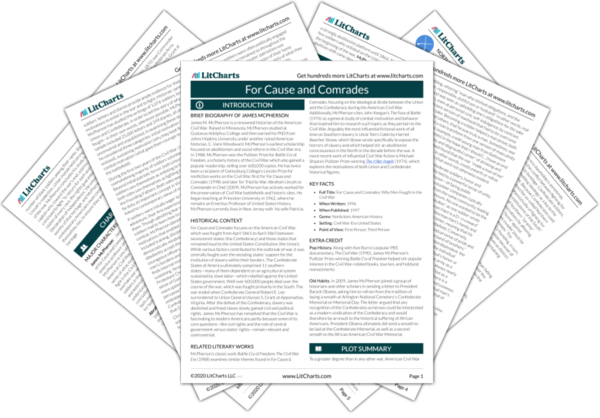Summary
Analysis
Part of the Victorian code of honor was “revenge for insult and injury.” Often, this meant hatred. Hatred and the desire for revenge appear to have grown stronger as the Civil War went on. Among Confederate soldiers, such sentiments were stronger. McPherson says this is partly because of the persistence of the “code duello” and partly because the South suffered such devastation over the course of the war.
The “code duello” simply refers to the code of one-on-one combat that persisted within Southern culture even after it was officially outlawed. It was part of a culture that valued personal honor highly and took insults to honor as grave offenses.
Themes
Though Southern perceptions of “Yankees” were bad even before the war got underway, the desire for vengeance became “almost an obsession” once fighting began in earnest. A Texas cavalry captain hoped for the death of “narrow-minded, bigoted […] nasal-twanged Yankees,” and a Georgia lieutenant told his wife to teach their children to bitterly despise and destroy Yankees.
The darker side of regional loyalties was a tendency to view enemies not just as combatants, but as objects of hatred—an animosity that transcended the battlefield. Though McPherson doesn’t explore the history of such animosity, it had long roots which were only strengthened by the war.
Themes
The destruction of Southern property helped intensify the desire for revenge. A Georgia sergeant on his way to Gettysburg said that he loved to kill immoral “vandals.” Though Confederate General Lee officially prohibited plundering on the way into Pennsylvania in 1863, this order was broadly disregarded. After the battle of Fredericksburg, a Confederate artillery officer described his enjoyment of the sight of dead and mutilated Yankees, saying it “[did] my soul good.” Black Union soldiers and their white officers were especially despised by Confederates. Even black soldiers attempting to surrender were often killed.
Some of the most notorious massacres of black Union captives occurred at Fort Pillow, Tennessee; Poison Springs, Arkansas; Plymouth, North Carolina; and Petersburg, Virginia. In 1864 at Fort Pillow, surrendering African American troops were brutally shot down. The details sof this event, such as whether General Nathan Bedford Forrest ordered the “massacre,” remain controversial.
Themes
Among Union soldiers, animosity toward “rebels” was strongest in border states and in East Tennessee (which was majority Unionist). It was fiercest among Confederate guerillas, as in West Virginia and in Missouri, who often held a “life or death” conviction of the need to killing secessionists. After Fort Pillow, some Union soldiers invading Georgia with Sherman’s army wanted to avenge their fallen fellow soldiers and “cleanse the country.”
West Virginia split off from Virginia and was formed as a free, non-slaveholding state in 1863. In Missouri, a “bushwhacking war” took place between pro-Confederate (“bushwhacker”) and pro-Union (“Jayhawk”) guerillas. These are just two examples of a historical picture that’s more complex than simply North versus South.
Themes
Get the entire For Cause and Comrades LitChart as a printable PDF.

McPherson describes the “rhetoric of revenge” as a “dark underside” to the patriotism that was necessary to maintain soldiers’ morale. Morale also fluctuated with the armies’ respective victories and defeats, with political news, and with controversies like the one over Emancipation. For example, Union morale flagged in the aftermath of the appointment of Joseph Hooker in January 1863, but after Union victory at Gettysburg that summer, morale was quite reversed. Conversely, losses at Gettysburg and Vicksburg brought Confederates almost to despair, and desertion grew more common.
One of the ugly truths of war is that positive morale isn’t necessarily the result of positive sentiments—sometimes, troops are motivated by a sense of vengeance. Other times, morale naturally fluctuates with the events of the battlefield, confidence in leadership, and the overall outlook of the respective sides.
Themes
By the time the Confederates surrendered at Appomattox, soldiers’ morale (especially in the Army of Northern Virginia) had withered. The South was economically battered and war-weary, whereas the North was coming off a string of victories and Lincoln’s reelection triumph. The Confederacy collapsed sooner than expected in the summer of 1865, yet its resilience up until this point was remarkable considering the unrelenting fighting of the past year.
For McPherson, the remarkable thing about morale is not that it eventually prevailed (for the victorious North) or collapsed (for the Confederacy), but how long both sides managed to sustain the will to fight.
Themes












